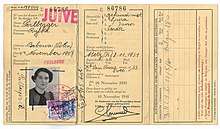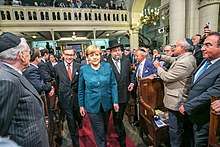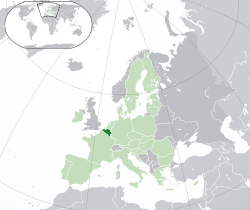History of the Jews in Belgium
The history of the Jews in Belgium goes back to the 1st century CE until today. The Jewish community numbered 66,000 on the eve of the Second World War[3] but, after the war and the Holocaust, is now less than half that number.
| Total population | |
|---|---|
| 30,000[1] | |
| Regions with significant populations | |
| Antwerp, Brussels | |
| Languages | |
| Dutch, French, Hebrew, Yiddish | |
| Religion | |
| Judaism | |
| Related ethnic groups | |
| Ashkenazi Jews, Sephardi Jews[2] |
Part of a series on the |
||||||||||||||||||||||||||||||||
|---|---|---|---|---|---|---|---|---|---|---|---|---|---|---|---|---|---|---|---|---|---|---|---|---|---|---|---|---|---|---|---|---|
| History of Belgium | ||||||||||||||||||||||||||||||||
 | ||||||||||||||||||||||||||||||||
|
||||||||||||||||||||||||||||||||
|
||||||||||||||||||||||||||||||||
|
||||||||||||||||||||||||||||||||
|
||||||||||||||||||||||||||||||||
|
Early Modern
|
||||||||||||||||||||||||||||||||
|
19th century
|
||||||||||||||||||||||||||||||||
|
20th and 21st centuries
|
||||||||||||||||||||||||||||||||
|
Timeline | ||||||||||||||||||||||||||||||||
Today, Belgium is home to more than 30,000 Jews, of whom two-thirds live in Antwerp.
History

Early history
The first Jews to arrive in the present-day territory of Belgium arrived with the Romans between the years 50 and 60 AD. Jews were mentioned in the Middle Ages in Brabant, and in 1261 Duke Henry III ordered the expulsion of Jews and usurers from the province. The Jewish community suffered further during the Crusades, as many Jews who refused to be baptised were put to death. This early community mostly disappeared after the Black Death persecutions 1348–1350, and finally the Brussels massacre, 1370.[4]
Sephardim
In the 16th century, many Sephardic Jews who had been expelled from Spain and Portugal settled in Belgium and the Netherlands. In addition, many Marranos (crypto-Jews who outwardly professed Christianity) settled in Antwerp at the end of the 15th century.
Later history
Austrian (Habsburg) rule in Belgium started in 1713. Particularly under Emperor Joseph II, Jews acquired more rights, such as those to practice crafts, own land, and operate their own cemeteries. A number of Ashkenazi Jews immigrated to the area in that period. The status of Jews in Belgium improved further under French and Dutch rule.
Shortly following Belgian independence in 1830, Judaism was given the status of an officially recognized religion (besides Roman Catholicism, the majority faith of the country, and Protestantism). On 17 March 1832 the Central Jewish Consistory of Belgium was founded as the official representative of the Jewish religion to the Belgian authorities. The Great Synagogue of Brussels was built in 1876–1877.
Around the turn of the century, the focal point of the world's diamond trade shifted from Amsterdam to Antwerp, bringing many Jewish diamond traders and polishers to the city. During World War I, many fled to the neutral Netherlands, but they returned after the war. Many Polish and Romanian Jews immigrated during the 1920s while Nazi persecutions brought waves of German and Austrian Jews in the 1930s.
Holocaust

Prior to the Second World War, and its peak, the Jewish community of Belgium consisted of roughly 70,000 Jews (35,000 resided in Antwerp and 25,000 in Brussels). About 22,000 Jews at that time were German Jewish refugees. Only 6% of the Jewish population were of Belgian nationality. Belgium was occupied by Nazi Germany between May 1940 and September 1944, and anti-Semitic policies were adopted throughout Belgium, even though popular resistance in some cities hindered their full application. Belgian local police rounded up Jews, on three occasions in Antwerp, assisting the German in fulfilling their murderous policy towards the Jews. Approximately 45% of the Belgian Jews (25.484 people) were deported to concentration camps from Dossin Barracks in Mechelen, primarily to Auschwitz. Only 1,200 of the deportees survived the war. The Committee for Jewish Defence, which worked with the national resistance movement Front de l'Indépendance, was the largest Jewish defence movement in Belgium during the war. Some Belgian Jews who fled Belgium in 1940 were deported on transports from Drancy, France. A total of 28,900 Belgian Jews perished between 1942 and 1945. Belgium was the only occupied country in which a transport (Train XX) was halted to give deportees a chance to escape.

The National Monument to the Jewish Martyrs of Belgium is in Brussels. More than twenty thousand names of Belgian Jewish victims are inscribed on the walls of the Monument, some of whom were killed on Belgian territory, but many of whom were shipped off to the death camps and executed in the East.
Today

Today, there are around 42,000 Jews in Belgium. The Jewish Community of Antwerp (about 20,000 people) is one of the largest single communities in Europe, and one of the last places in the world where Yiddish is its primary language (mirroring certain Orthodox and Hassidic communities in New York and Israel). In addition a very high percentage (95%) of Jewish children in Antwerp receive a Jewish education. In contemporary Belgium, five Jewish newspapers and more than 45 active synagogues exist, 30 of which are in Antwerp.
Antisemitic incidents
According to JTA[5] report, the number of antisemitic incidents in 2012 was the highest since 2009. 80 antisemitic incidents were reported throughout Belgium in 2012, a 23% increase from 2011 and an overall increase of 34% since 2000. Five of the incidents involved physical attacks, three of which occurred in Antwerp.[6]
In October 2013, Isi Leibler, the former president of the Executive Council of Australian Jewry, reported on the alarming increase in the levels of antisemitism in Belgium. Leibler described a wide use of antisemitic caricatures in the media including a caricature on the official central Flanders educational website, comparing Israel to Nazi Germany. In addition, he described an increase of 30% in the number of antisemitic incidents including physical assaults and vandalism of Jewish institutions.[7] Furthermore, according to a survey conducted among eight Jewish communities in eight European Union countries, 88% of Belgian Jews feel that in the course of recent years, antisemitism has intensified in their country. 10% of the Belgian survey respondents reported suffering from incidents of physical violence or threats due to their Jewish affiliation since 2008. Most of the victims did not report the incidents to the police.[8]
The increased frequency of antisemitic attacks started in May 2014, when four people were killed in a shooting at the Belgian Jewish Museum in Brussels.[9] Two days later, a young Muslim man entered the CCU (Jewish Cultural Center) while an event was taking place and shouted racist slurs.[10] A month later, a school bus in Antwerp, that was driving 5-year-old Jewish children was stoned by a group of Muslim teens.[11] Towards the end of August 2014, a 75-year-old Jewish woman was hit and pushed to the ground because of her Jewish-sounding surname.[12] The Coordination Forum for Countering Antisemitism reported six racist incidents, three of which tool place as a part of different demonstrations againstOperation Protective Edge in Gaza (July–August 2014). Those demonstrations included antisemitic slurs such as "slaughter the Jews" and "Death to the Jews."[13]
Aalst annual carnival
Every year, the Flemish city of Aalst holds a three-day carnival attracting tens of thousands of people. In 2009, UNESCO added the carnival to its extended Intangible Cultural Heritage List.[14] In March 2019, the carnival included a float that featured caricatures of large-nosed religious Jews with side curls standing next to bags of money, with one carrying a rat on its shoulder.[15] The float was widely condemned by major European Jewish groups and Belgium's Jewish community.[16] In a report to UNESCO following a complaint by the Forum der Joodse Organisaties, Unia, the country's watchdog on racism, said the float was of a clearly antisemitic kind, but that no laws were breached. In the context of folklore, there was no intent to incite towards discrimination and then stereotypes are not illegal.[17]
After the city's mayor refused to ban a repeat of such displays, he asked UNESCO through a statement to regional TV Oost[18] to strip the Aalst carnival of World Heritage status, which UNESCO did in December 2019, “over recurring repetition of racist and antisemitic representations.”
Data and Analysis
A review study published in 2015 by the Institute for the Study of Global Antisemitism and Policy (ISGAP) revealed that in a survey conducted in Brussels, more than half of the Muslim origin respondents agreed with antisemitic statements, such as: "Jews want to dominate everything" and “Jews incite to war and blame others”. The review, which analysed a few studies regarding antisemitism in Europe, found that the level of antisemitic attitudes is significantly higher among Muslims than among non-Muslims.[19]
An ADL (Anti-Defamation League) audit published in June 2015 revealed an increase in level of concern about violence against Jews in Belgium. In addition, 7% of the participants claimed that the number of Jews who died in the Holocaust has been greatly exaggerated by history. In a follow-up survey 53% of the respondents agreed with the state: "Violence against Jews is a symptom of deep anti-Jewish feelings among some people in my country". The ADL also conducted a research of anti-Jewish attitudes inside the Muslim population of Belgium. The results showed that 82% of Muslim Belgium agreed with the state "Jews have too much power in the business world", compared to 36% of the national population who agreed with it. In all eleven categories included in the research, the Muslim population reached higher levels of agreement with anti-Jewish stereotypes.[20]
On 2015 the Fundamental Rights Agency published its annual overview of data on antisemitism available in the European Union. The finding of the file presents a persistent increase in the number of antisemitic incidents in Belgium through the last ten years. Data of the Interfederal Centre for Equal Opportunities displayed in the file, shows that 130 Complaints of antisemitism were received during 2014, compared to 85 complaints in 2013. Furthermore, the number of incidents in each category has increased in 2014, compared with 2013.[21]
The ADL (Anti-Defamation League) published on 2016 an update for their "ADL Global 100",[22] that contained an update of the antisemitic attitudes toward Jews in Belgium. The findings showed a decrease in the percentage of the population harboring antisemitic attitudes (21% in 2015, compare to 27% in 2014). In addition, the survey shows that 46% of the respondents agree with the phrase "Jews are more loyal to Israel than to this country", and that 39% of the respondents agree with the phrase "Jews still talk too much about what happened to them in the Holocaust".[23]
Notable people
See also
- Chaim Kreiswirth, the former Chief Rabbi of Antwerp
- Eisenman Synagogue
- History of the Jews in Antwerp
References
- American Jewish Year Book. "The Jewish Population of the World (2010)". Jewish Virtual Library. Retrieved 3 August 2014.
- https://web.archive.org/web/20160220092104/http://www.jhm.nl/culture-and-history/the-netherlands/introduction
- "Belgium" (PDF). Yad-Vashem.
- Au nom de l'antisionisme: l'image des Juifs et d'Israël dans la ... p27 Joël Kotek, Dan Kotek - 2005 "Des émeutes antijuives s'ensuivent. La profanation de l'hostie, que les chrétiens identifient à la personne même du Christ, serait la répétition du crime du calvaire. En 1370, une vingtaine de Juifs sont brûlés à Bruxelles."
- http://www.jta.org/
- "Antisemitism intensifies in Belgium". CFCA. Retrieved 23 November 2013.
- "4 killed in shooting outside Jewish Museum in Brussels". CFCA. Retrieved 25 May 2014.
- "Antisemitic threats near the CCU (Jewish Cultural Center) building". The Coordination Forum for Countering Antisemitism. Retrieved 29 June 2014.
- "School bus carrying ultra-Orthodox Jewish children stoned in anti-Jewish attack". The Coordination Forum for Countering Antisemitism. Retrieved 29 June 2014.
- "Antisemitic attack against 75 old woman". CFCA. La- Libre. Retrieved 26 August 2014.
- "Demonstration features calls to 'slaughter the Jews". CFCA. JTA. Retrieved 26 July 2014.
- A Belgian parade may lose its place on UNESCO’s World Heritage List after it allowed an anti-Semitic float
- Israel welcomes Belgian parade's removal from UNESCO list
- UNESCO Removes Belgium Carnival With Antisemitic Float From Heritage List
- ""Eigenlijk zegt Unia: 'De Joden moeten niet zo zagen'"". Het Laatste Nieuws. 25 October 2019. Retrieved 10 March 2020.
- "Unesco removes 'racist' Belgian carnival from heritage list". The Guardian.
- Jikeli, Gunther. "Antisemitic Attitudes Among Muslims in Europe A Review of Recent Surveys". Institute for the Study of Global Antisemitism and Policy. Archived from the original on 2 April 2015. Retrieved 30 March 2015.
- "ADL Global 100- An Index of Antisemitism" (PDF). Anti-Defamation League. Retrieved 20 July 2015.
- "Antisemitism Overview of data available in the European Union 2004–2014" (PDF). European Union agency for fundamental rights. Retrieved 20 December 2015.
- "ADL Global 100:". global100. ADL. Retrieved 25 February 2016.(An international survey conducted in 2013-2014 to measure antisemitic opinions in 100 countries around the world)
- "Belgium 2015". gobal100. ADL. Retrieved 25 February 2016.
Further reading
- Moore, Bob. "Jewish Self-Help and Rescue in the Netherlands during the Holocaust in Comparative Perspective," Tijdschrift voor Geschiedenis (2011) 124#4 pp 492–505, a comparison with Belgium
- Rogeau, Olivier; Royen, Marie-Cécile (28 January 2011). "Juifs de Belgique" (PDF). Le Vif. Katholieke Universiteit Leuven. Archived from the original (PDF) on 2 October 2013. Retrieved 27 September 2013.
External links
- Jewish Belgium
- Chabad-Lubavitch centers in Belgium
- The Virtual Jewish History Tour - Belgium at Jewish Virtual Library
- visitbelgium.com/jewish, Jewish sites in Belgium
- Jewish Museum of Deportation and Resistance This museum in Mechelen traces the story of the many Jews who were deported during the occupation. The archives are accessible to those seeking information on the fate of family members.


